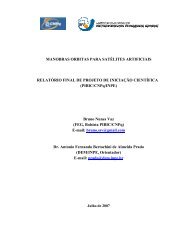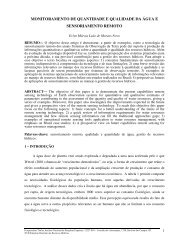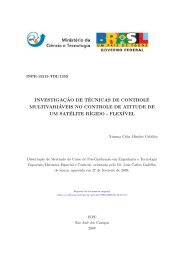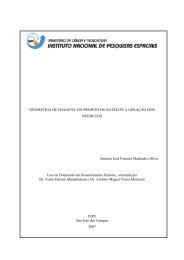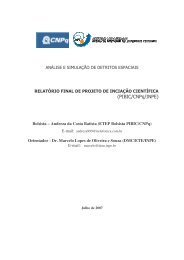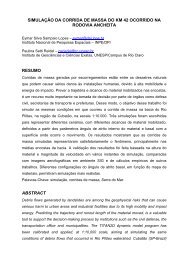Estruturas de barreira dupla de PbTe/PbEuTe ... - mtc-m17:80 - Inpe
Estruturas de barreira dupla de PbTe/PbEuTe ... - mtc-m17:80 - Inpe
Estruturas de barreira dupla de PbTe/PbEuTe ... - mtc-m17:80 - Inpe
Create successful ePaper yourself
Turn your PDF publications into a flip-book with our unique Google optimized e-Paper software.
<strong>PbTe</strong>/<strong>PbEuTe</strong> DOUBLE BARRIER STRUCTURES GROWN BY MOLECULARBEAM EPITAXYABSTRACTThis work reports the growth of <strong>PbTe</strong>/Pb 1-x Eu x Te double barrier (DB) structures bymolecular beam epitaxial and the <strong>de</strong>vice processing aiming the resonant tunnelingmeasurement. The samples were grown on (111) BaF 2 substrates at 300°C. Resistivityand Hall effect measurements were performed on reference films to <strong>de</strong>termine the mostsuitable electrical properties of each layer of the DB structure. <strong>PbTe</strong> layers with electronconcentration of n ~ 10 17 cm -3 for the spacers and the well were controlled bystoichiometric <strong>de</strong>viation through the additional Te flux. The highest Hall mobility at77 K of 1.5x10 4 cm 2 /Vs was obtained just near the n to p transition range, whichoccurred abruptly at a beam flux ratio between Te and <strong>PbTe</strong> close to 0.02. To obtainlayers with higher electron concentration, a study of Bi doping on <strong>PbTe</strong> was performed.<strong>PbTe</strong> films with n values between 1x10 17 e 4x10 19 cm -3 were obtained by increasing theBi 2 Te 3 effusion cell flux. Resistivity and Hall effect measurements at temperature from10 to 320 K were done for these films. The results indicate that Bi atoms wereeffectively incorporated to <strong>PbTe</strong> as active donors. No thermal activation was observedfor these doping levels, indicating that Bi has ad<strong>de</strong>d resonant levels with the conductionband. Mobility curves show that the <strong>PbTe</strong> layers tend to a metallic behavior, when theelectron concentration increases. Values of n around 10 19 cm -3 are suggested as the mostappropriate for the contact layers in the <strong>de</strong>vice. The beam flux ratio of 2.2 between Teand Eu was consi<strong>de</strong>red as the most suitable for the growth of the Pb 1-x Eu x Te barrierreference layers. Using the Fourier transform infrared spectra, the europiumconcentration of x = 0.050 was obtained, close to the nominal concentration ofx = 0.044 predicted from the beam flux ratio between Eu and <strong>PbTe</strong>. Consi<strong>de</strong>ring a bandoffset of 50% between the conduction and valence bands, a barrier height of 150 meV isfound for the <strong>PbTe</strong>/Pb 0.95 Eu 0.05 Te interface. A set of <strong>PbTe</strong>/Pb 0.95 Eu 0.05 Te DB sampleswas grown with nominal thicknesses, estimated by the growth rates, of 12 nm for thespacers, 5 nm for the well, from 2.5 to 100 nm for the barriers and 36 nm for the caplayers. To obtain the structural parameters, high-resolution x-ray diffraction spectrawere measured around the (222) Bragg peak. From the best fit of the calculated spectra,using Takagi-Taupin equations, to the measured ones, the individual thickness of thelayers that compose the DB structure was precisely <strong>de</strong>termined. A good agreementbetween the nominal thicknesses and the values obtained from the x-ray analysis wasachieved, except for layers thinner than 10 nm, where a discrepancy up to 40% wasobserved. The x-ray analysis also revealed that abrupt interfaces were obtained duringthe MBE growth, and that the Pb 0,95 Eu 0,05 Te barriers are completely strained to the <strong>PbTe</strong>layers insi<strong>de</strong> the DB structures up to thicknesses of 100 nm. The IxV curves of the DBmesa <strong>de</strong>vices exhibit an ohmic behavior, confirming the Bi doping efficiency in thecontact layers. Leak currents through the mesa edges were consi<strong>de</strong>red to be the mainreason which prevents the <strong>de</strong>tection of resonant tunneling in the <strong>PbTe</strong>/<strong>PbEuTe</strong> doublebarrier structures.



